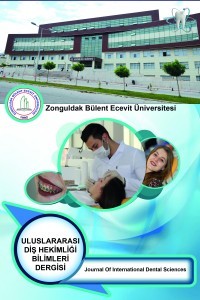Titanyum İmplantlar Üzerinde Biyofilm Oluşumu, in situ 24 saat
Titanyum, Asit pürüzlendirilmiş, Cilalı, Biyofilm, in situ
Biofilm Formation on Titanium Implants, 24h in situ
Titanium, Acid etched, Polished, Biofilm, in situ,
___
- 1. Lausmaa J. Surface spectroscopic characterization of titanium implant materials. Journal of Electron Spectroscopy and Related Phenomena,1996 81, 343-361.
- 2. Lausmaa J. Mechanical, Thermal, Chemical and Electrochemical Surface Treatment of Titanium. In: Brunette DM, editor. Titanium in medicine: material science, surface science, engineering, biological responses and medical applications. Berlin: Springer, 2001; 1019.
- 3. Xiao S J, Textor M, Spencer N D, Sigrist H, Langmuir 1998; 14: 5507–5516.
- 4. Marshall, K. C. Mechanisms of adhesion of marine bacteria to surfaces. Proceedings of the Third International Congress on Marine Corrosion and Fouling. United States National Bureau of Standards Special Publication. 1973.
- 5. Zhao, Q.; Xu, X.; Zhang, H.; Chen, Y.; Xu, J.; Yu, D. Applied Physics A, 2004; 79, (7), 1721-1724.
- 6. Hetrick, E.M.; Schoenfisch, M.H. Reducing implant-related infections: Active release strategies. Chem. Soc. Rev.2006; 35, 780–789.
- 7. Harris, L.G.; Richards, R.G. Staphylococci and implant surfaces: A review. Injury, 2006; 37, S3–S14.
- 8. Dunne, W.M., Jr. Bacterial adhesion: Seen any good biofilms lately Clin. Microbiol. Rev., 2002; 15, 155–166.
- 9. Hannig C; Hannig MThe oral cavity --a key system to understand substratum- dependent bioadhesion on solid surfaces in man. Clinical Oral Investigations 2009; 13:123- 139.
- 10. Hannig M, Khanafer AK, Hoth-Hannig W, Al-Marrawi F, Açil Y, Transmission electron microscopy comparison of methods for collecting in situ formed enamel pellicle. Clin Oral Investig 2005; 9:30-37.
- 11. Hannig, C., Hannig, M., Rehmer, O., Braun, G., Hellwig, E. & AlAhmad, A.. Fluorescence microscopic visualization and quantification of initial bacterial colonization on enamel in situ. Arch Oral Biol 2007; 52, 1048–1056.
- 12. Hannig, M. Transmission electron microscopy of early plaque formation on dental materials in vivo. Eur J Oral Sci 1999;107, 55–64.
- 13. Walsh WR, Svehla MJ, Russell J, et al. Cemented fixation with PMMA or Bis-GMA resin hydroxyapatite cement: effect of implant surface roughness. Biomaterials. 2004; 25:4929–4934.
- 14. Khang D, Kim SY, Liu-Snyder P, Palmore GTR, Durbin SM, Webster TJ. Enhanced fibronectin adsorption on carbon nanotube/poly(carbonate) urethane: independent role of surface nano-roughness and associated surface energy. Biomaterials. 2007; 28:4756–4768.
- 15. Jin C., Normani S. D. & Emelko M. B. Surface Roughness Impacts on Granular Media Filtration at Favorable Deposition Conditions: Experiments and Modeling. Environ. Sci. Technol. 49 7879–7888 (2015).
- 16. Vinogradova O. I. & Belyaev A. V. Wetting, roughness and flow boundary conditions. J. Phys: Condens Matter 23, 184104 (2011).
- ISSN: 2149-8628
- Yayın Aralığı: Yılda 3 Sayı
- Yayıncı: Zonguldak Bülent Ecevit Üniversitesi
Gargaraların Diş Eti Rengindeki Kompozitlerin Mikrosertliği ve Renk Değişimi Üzerine Etkileri
Alperen DEĞIRMENCI, Beyza ÜNALAN DEĞIRMENCI
İmplant Destekli Sabit Protezlerde Simantasyon
Neşet Volkan ASAR, Emine Ayça KIRMAN
Üç Kanallı Üst Çene Birinci Küçük Azı Dişinin Endodontik Tedavisi: Olgu Sunumu
Oğuzhan YALÇIN, Ebru ÖZSEZER DEMİRYÜREK
Non Sendromik Gömülü Sürnümere Premolar: İki Olgu Sunumu
Dentoalveolar Cerrahide Ozon Tedavisi
Serap KESKİN TUNÇ, Nazlı Zeynep Alpaslan YAYLI, Tolga BAYAR
Ağız Diş Sağlığının Yaşam Kalitesine Etkisi ve Yaygın Değerlendirme Yöntemleri
Ekin BEŞIROĞLU, Müge LÜTFIOĞLU
Ortodontide Modern Tanı ve Tedavi Araçları
Abdullah Bahadır AKÇA, Hüseyin Ozan ŞAHİN
Unilateral Daimi Mandibular İkinci Premolar Eksikliği: Olgu Sunumu
Hüseyin Ozan ŞAHİN, Tamer TÜRK
Titanyum İmplantlar Üzerinde Biyofilm Oluşumu, in situ 24 saat
